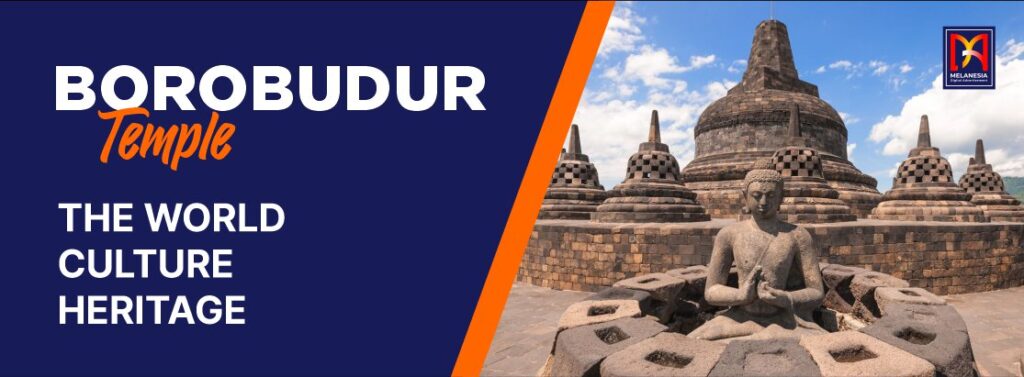Borobudur Temple is a Buddhist temple located in Borobudur, Magelang, Central Java, Indonesia. This temple is located approximately 100 km southwest of Semarang, 86 km west of Surakarta, and 40 km northwest of Yogyakarta. This temple with many stupas was founded by adherents of Mahayana Buddhism around the year 800 AD during the reign of the Syailendra dynasty. Borobudur is the largest Buddhist temple or shrine in the world, as well as one of the largest Buddhist monuments in the world.
Borobudur Temple is like a mandatory tour for tourists in Jogja. Even though it is located in Magelang, Borobudur Temple can be reached in just 1.5 hours by private/rented vehicle from downtown Jogja.
The car parking area at Borobudur Temple is quite large and has lots of shade trees. Weekday rates differ from weekends and public holidays.
Monday – Thursday
- Car: IDR 10,000
- Buses: IDR 20,000
Friday – Sunday, and National Holidays
- Car: IDR 15,000
- Buses: IDR 25,000
The courtyard/courtyard of Borobudur Temple is open daily from 07:00 to 17:00. The best time to visit Borobudur Temple is early in the morning, when the air is still fresh. The ticket booth is open from 6:30am to 4:30pm. However, you can also buy tickets online.
The entrance ticket to Borobudur Temple is IDR 50,000 for adults and IDR 25,000 for children 3-10 years. There is a 50% discount for groups of students, a minimum of 20 people. but for now tours to Borobudur temple can only get to the courtyard. if you want to go up to the temple, visitors must hire a guide at Borobudur temple.
If you want to save more, there are tickets for Borobudur Temple + Prambanan Temple Rp. 75,000 for adults and Rp. 35,000 for children 3-10 years. This canal ticket is valid for 2 days, so it can still be used the next day. There are also Borobudur + Ratu Boko Temple pass tickets, prices and conditions are the same.
This monument consists of six square terraces on which there are three circular courtyards, the walls are decorated with 2,672 relief panels and originally there were 504 Buddha statues. Borobudur has the most complete and largest collection of Buddhist reliefs in the world. The largest main stupa is located in the center as well as crowning this building, surrounded by three circular rows of 72 perforated stupas in which there is a Buddha statue sitting cross-legged in a perfect lotus position with the Dharmachakra mudra (turning the wheel of dharma).
This monument is a model of the universe and was built as a holy place to glorify Buddha as well as to function as a place of pilgrimage to guide mankind from the world of worldly desires to enlightenment and wisdom according to Buddhist teachings. Pilgrims enter via the east side and start the ritual at the base of the temple by walking around this sacred building in a clockwise direction, while continuing to ascend to the next steps through three levels of realms in Buddhist cosmology. The three levels are Kāmadhātu (the realm of lust), Rupadhatu (the realm of form), and Arupadhatu (the realm of intangibility). On their way the pilgrims walk through a series of aisles and stairs to witness no less than 1,460 beautiful relief panels engraved on the walls and balustrades.
According to historical evidence, Borobudur was abandoned in the 10th century as the center of the Ancient Mataram Kingdom was moved to East Java by Pu Sindok. The world began to realize the existence of this building since it was discovered in 1814 by Sir Thomas Stamford Raffles, who at that time served as the British Governor General over Java. Since then Borobudur has undergone a series of rescue and restoration efforts. The largest restoration project was carried out from 1975 to 1982 under the efforts of the Government of the Republic of Indonesia and UNESCO, then this historic site was included in the list of World Heritage Sites.
Borobudur is still used today as a place of religious pilgrimage; every year Buddhists who come from all over Indonesia and abroad gather at Borobudur to commemorate the Vesak Trisuci. Regarding tourism, Borobudur is the single tourist attraction in Indonesia that is visited by the most tourists.
On February 11, 2022, the government formalized the status of Borobudur Temple again as a place of worship for Buddhists in Indonesia and the world.
There is a joke among Jogja car rental drivers. That said, the Indonesian will visit Borobudur Temple at least 4 times in his lifetime. The first visit to Borobudur Temple is usually during a study tour in high school. Second visit with boyfriend while in college. The third visit was accompanying parents after the graduation ceremony. The fourth visit brought his wife and children while on vacation to Jogja. It’s enough that our article about Borobudur Temple, Yogyakarta, see you 🙂
Pros:
- The Largest Buddhist Monument in the World
- Has the most complete and largest collection of Buddhist reliefs in the world
- Buddha statues and stupas
- World Heritage
Cons:
- It is forbidden to bring food and drinks from outside.
- The quota is limited to 1200 people/day
- visitors are no longer allowed to go up to the temple without a tour guide



